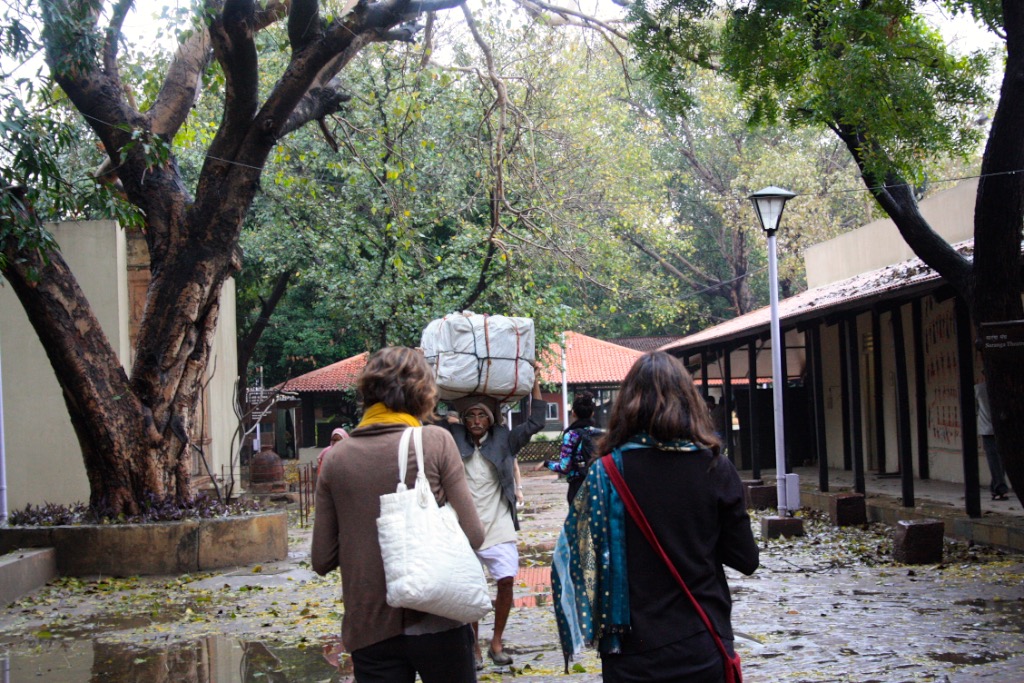A Visit to the National Handicrafts Museum in New Delhi
Hailey Fynaardt
On the first day of our trip to India this past March, it was pouring rain so our planned visit to the outdoor pottery studios was cancelled (rain plus clay equals mud), which actually worked out perfectly because we were able to visit the newly renovated National Handicrafts Museum in New Delhi instead. The Museum includes several stone courtyard areas that encompass beautiful trees and a few structures with painted fresco walls, tiny doorways, and tile roofs. I vaguely recall a tour guide attempting to shuffle us around, but he must have quickly realized that trying to maintain the attention of twelve foreign girls who had stepped off a plane only hours before, would be like herding cats, because for the rest of the time we were left to explore on our own. The rain must have deterred other visitors that day because we had the entire property to ourselves to explore, take photos, get to know one another, and embrace the fact that we were, finally, in India.
After seeing the Museum's large collection of bronze statues and a huge wooden chariot with head-high wheels, we discovered the hidden gem, the Indian fabric and textile exhibit which was spread throughout a two-story rustic concrete building. This was by far my favorite part of the visit, and where my art-history loving heart went wild. Huge embroidered tapestries, intricate tie-dyed silk fabrics, and beautiful saris were simply framed and hung along the walls or tucked behind glass cases. There was no special lighting aside from a few bare lightbulbs, no air-conditioning or climate-control systems, and only a few sparse information cards tacked to the wall. There were no elaborate galleries or displays, no security guards (except for the one that appeared out of nowhere every time I attempted to snap a photo) and ultimately no distractions, so the only things that commanded our attention were the textiles themselves.
I stood, as I usually do when I visit Museums, as close to the pieces as possible, trying to study every stitch, every stroke, every layer, and every line on the surface, while my memory filtered through the photos, textbooks, and lectures I studied in school. But without the crutch of a shiny placard or visitor's brochure identifying the work, in this slightly damp concrete building in Delhi, my imagination simply ran wild. I thought about the hands that made each piece and who had taught them how to move the thread over the fabric. I thought about the design, and what inspired the patterns and symbols. I imagined the processes the artists used in creating the dyes from raw pigments, and spinning silken threads onto spools, and how they carved or forged the needles that pulled the colors through the layers of material. I thought of who may have commissioned the piece, who it was worn by, and on what occasion, or perhaps if it was used in a palace as a bedspread or in a temple as a prayer rug.
Some of the tapestries contained narratives from the Quran whereas others featured Hindu gods and goddesses, and others were reminiscent of South Asian cultures, reminding us that India is as diverse in culture and history as it is in geography. Without looking at a map, it's hard to imagine that India's borders reach from the Middle East, to the base of the Himalayas, to Southern Asia, and into the Arabian Sea. And although we think of it today as a relatively peaceful place, thanks to the efforts of great leaders like Ghandi and Mother Theresa, India has served as the center of cultural, political, and spiritual unrest for most of its long history. In this way, the museum was a great introduction for us all to recognize how unique and diverse this beautiful country truly is.
So often we attempt to understand or value artwork based on the actual piece itself- cocking our heads and scanning the surfaces of objects for meaning and beauty- when what makes art so important is that it is often less about the end result as it is about the process of creating it. Sure, a Caravaggio painting, Michelangelo sculpture, or an ancient Indian textile are beautiful to look at, but the artist's process of experimenting with raw materials, grinding pigments, testing out techniques, and even acquiring the commission to begin with, is where the real story begins. Unlike artwork today, ancient pieces were often as useful as they were beautiful, serving a religious, cultural, or political purpose in addition to being aesthetically pleasing or impressive. Part of a piece's value comes from not only who made it, or the materials that were used, but who it had belonged to and how it was used. Oftentimes, there may not be anything remarkable about an object itself, but if it was owned by a prominent figure, made using a unique process, or has survived catastrophic circumstances, it is inherently valuable as a tangible piece of history.
Although our original itinerary did not include a visit to the crafts museum, I am so glad we were able (or forced by the weather) to go when we did because there is talk of the property being converted into an academy which may mean the museum's collection could be sold or lent to other collections. I hope this isn't true, but if you plan to visit Delhi sometime soon, make sure you put a visit to the National Handicrafts Museum on your must-do list.
Thanks for reading!
Hailey











